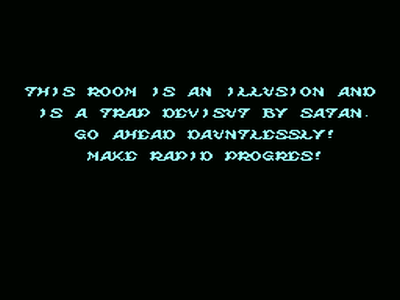
Even unencumbered by armour, Arthur clunketh along with the surefooted grace of a drunken hippopotamus.
LATTERLY, Capcom, erstwhile titan of video game development, hath fallen intro strife. Its monuments lie in ruins, its heroes of design and creativity have made good their exit, and its triumphs are near forgot by those gamers who today hold in esteem titles more visually attractive. Spectacle and show o’ercome all other concerns so that the modern gamer doth, like unto a babboon, gape and gawk with mouth all agog at the flashing and blinking lewdnesses and vices on display, ripe for perusal and, indeed, for purchase.
But, whilom, ’twas not so. For Capcom hath fallen into these pressing circumstances from lofty heights formerly occupied with a surety. Deep is the abyss into which it hath sunk–and rightly withal. For, the crimes of Capcom are severe, and none moreso than the development of Ghosts ‘n Goblins published on nearly every platform imaginable since its release to arcades in September of 1985. From that time henceforward, this world hath suffered mightily from the affliction of Ghosts ‘n Goblins blighting first one console, then another, with the advent of Virtual Consoles only worsening the matter by making available again to unwary moderns the failures of the past. Today, the hapless gamer, playing Ghosts ‘n Goblins uninformed, doubteth whether any game of the past is like to bring happiness or joy.
For what manner of torturework hath Capcom deserv’d its terrible fall? To be sure, brethren, the work of Ghosts ‘n Goblins is an abomination in the sight of the mighty hand which worketh all causes to the Good. From the shrieking tones of the first bars of the soundtrack, the unhappy player knoweth well that what soon shall follow bringeth no gaity. The painful, screeching noise is compounded by the high-pitched squeal–not entirely unlike that sound attendant upon the slaughter of a well-voiced swine–which cometh solely from the use of Arthur’s weapon. To this further is added sound after sound, similar in intensity and disagreeableness, the which emaneteth from the small selection of monsters that populate the game. And indeed, they are few in number. The game reuseth monsters and bosses to such a degree that nearly everything can be witnessed in the first two stages alone.
With ears shattered by the shrieking soundtrack, enemies, and weapons alike, the player may be of a mind like to quit Ghosts ‘n Goblins ere it hath hardly begun. But then the player should miss that which cometh next: six stages, replete with enemies whose movements are devis’d with a randomness taken straight out of that other work of malice, Deadly Towers E’en equipped with save states, the unfortunate gamer will discover that, each time reloaded, the monsters and game doth behave differently: sometimes so as to make the game impossible, sometimes not.

Near the end of his quest, Arthur climbeth many vertical labyrinths, fighting winged demons that he might progress.
In story alone Ghosts ‘n Goblins doth stand ahead of the other vile works of the Enemy. For, in presenting a story so brief and simplistic that it can be compass’d in the opening cutscene alone–“a devil hath taken the princess; savest her, thou knight!”–it also hath managed thereby to provide a player with all he must know. All this is typical of stage-based platformers of the era: indeed, it surpasseth that found in near predecessors. Super Mario Bros., for example, presenteth no such story hook.
But, truly lamentable are the controls, which casteth into disarray and confusion any momentary pleasure deriv’d from the story. This reviewer, who hath no small experience with yon game, was confounded for some minutes by Arthur’s propensity to kneel and remain kneeling. After increasing irritation, this reviewer did switch the very controller, only to discover that ’twas the design of the game, not any fault of the peripheral. So, too, are Arthur’s jumps fiddly, the physics undependable, the collison detection faithless, and the engine itself unstable withal.
Arthur stutteringly climbeth a ladder, only to get stuck at the top trying to disembark. Monsters shoot down the ladders and hover atop the ladders, take ten hits to kill, and idle nearby whilst the clock counteth quickly the two minutes afforded. The experience is a concatenation of frustrations layered like an onion, and just as like to coax forth tears.
As the music screecheth, and the engine stuttereth, and Arthur stumbleth, and the array of monsters weareth out its welcome, and the player wearyeth from an experience too tiresome and painful readily to be devis’d in words, still doth Ghosts ‘n Goblins wear on, like an inebriate, Australian uncle, uninvited to the family reunion, but present nevertheless. Keen to partake of a beer, and another, and another, he drinketh until–shambolic and tight as an owl–he urinateth in the urn holding the ashes of great aunt Nora. Cast out from the gathering, his departure is met with sighs of relief: ’tis enough, and he is well gone. –Until it is found, some hours later, that he hath deposited a goodly quantity of his stools right atop the plum pudding meant for the familial dessert.
This is the end of Ghosts ‘n Goblins. The boss battles, randomised between easy and impossible do, once vanquished, give way to a boss fight that can be predictably beaten in a few seconds each and every time (controls notwithstanding). The final battle is followed by the worst aspect of all–far worse than anything heretofore related. A message, improperly rendered into English, asserteth thus: that the final chamber was an illusion and that, moreover, Arthur must again assaileth the keep of the enemy, and every stage and boss withal, that the true ending might thereby be achieved.
If, at such a time, following upon such travails, the player doth not become unhinged, doth not bestir himself to the destruction of the game cartridge, doth not betake himself thence to a place of debarkation, doth not arrive in Japan seeking the demise of those responsible for the offending title, doth not commit many savage acts of gruesome and deadly murder, and doth not find himself arrested for his violent and terrible actions–then such a player hath more patience and self-control than this reviewer who even now, of consequence attendant upon the actions latterly related, languisheth as prisoner gaoled in cell, where, awaiting his own Arthur, he prayeth that he might anon be rescued.



